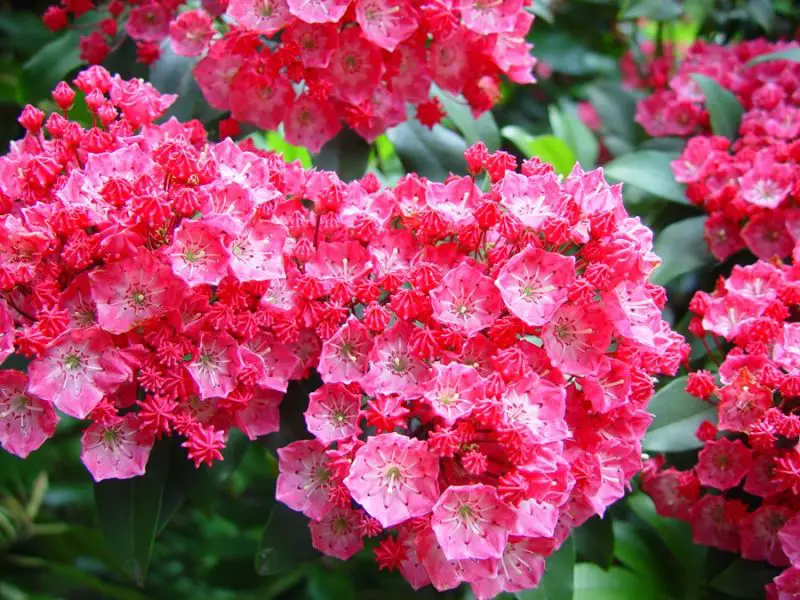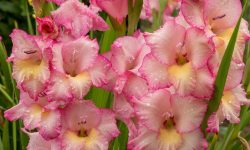Mountain Laurel, scientifically known as Kalmia latifolia, is a stunning native shrub of North America. Its delicate, cup-shaped flowers bloom in shades of soft pink to pure white, creating a breathtaking display in spring. This versatile plant thrives in well-drained, acidic soils with filtered sunlight. Mountain Laurel is often planted in gardens, parks, and natural landscapes to add seasonal beauty and visual interest. Beyond its ornamental value, it contributes to local ecosystems by attracting pollinators such as bees and butterflies, which support other plants in the area.
Understanding the growth habits and care requirements of Mountain Laurel is essential for achieving vibrant spring blooms. The plant prefers consistent moisture, rich organic soil, and partial shade to maintain healthy foliage and strong flowering. Proper placement and attention to soil conditions can ensure your Mountain Laurel thrives, offering year-round greenery and a spectacular floral display that marks the arrival of spring.
Understanding Mountain Laurel Bloom Cycle

Mountain Laurel has a distinct bloom cycle that gardeners should understand to enjoy vibrant spring flowers. The plant typically begins its flowering period in late spring, often around May, depending on the climate and local conditions. Flower buds develop gradually over several weeks, with each cluster taking time to open fully. Early bloomers may show hints of color in April, while peak flowering usually occurs in late May. Recognizing these stages helps gardeners anticipate the best time to admire the flowers.
The bloom cycle of Mountain Laurel is influenced by both environmental factors and plant health. Adequate sunlight, proper soil acidity, and consistent moisture encourage strong bud formation. Conversely, drought, poor soil, or excessive shade can delay or reduce flowering. Temperature fluctuations also play a role; unusually cold springs can slow down bud development, while mild, steady temperatures often lead to longer and more vibrant blooms. Gardeners can monitor bud progression to predict when the plant will be in full bloom, planning garden displays or pruning accordingly.
Understanding the bloom cycle is not just about timing; it helps maintain overall plant health. By observing when Mountain Laurel forms buds and flowers, gardeners can adjust watering, fertilization, and protection measures to support its growth. This knowledge ensures the plant produces abundant blossoms each spring, enhancing garden aesthetics and supporting local pollinators. A well-timed care routine aligned with the bloom cycle maximizes flowering potential and prolongs the plant’s seasonal beauty.
When Does Mountain Laurel Bloom
Mountain Laurel typically blooms in late spring, creating a spectacular display in gardens and natural landscapes. In most regions of the eastern United States, flowers begin appearing in May. However, the exact timing can vary depending on climate, altitude, and local weather patterns. Warmer areas may see blooms as early as late April, while cooler mountainous regions might not experience peak flowering until early June. Understanding this timing helps gardeners plan visits, landscape displays, and maintenance tasks.
The bloom period for Mountain Laurel usually lasts two to three weeks, with each cluster of flowers gradually opening. Flowers start as tight buds and slowly unfurl into star-shaped blossoms. Peak bloom is often reached in mid-May, when the plant is covered in dense, colorful clusters. After this peak, individual flowers begin to fade, but the foliage remains attractive throughout the season. Gardeners who want extended visual impact can plant multiple shrubs with staggered bloom cycles to ensure continuous color.
Environmental conditions strongly influence when Mountain Laurel blooms. Adequate sunlight, well-drained acidic soil, and consistent moisture encourage timely flowering. Conversely, drought, frost, or nutrient deficiencies can delay bloom or reduce the number of flowers. Monitoring local weather trends and providing proper care ensures the plant reaches full flowering potential. By understanding the natural bloom window and the factors affecting it, gardeners can enjoy the vibrant beauty of Mountain Laurel each spring and create lasting seasonal displays.
Regional Blooming Differences of Mountain Laurel
Northeastern United States
In the Northeastern United States, Mountain Laurel typically blooms from late May to early June. Cooler temperatures and longer winters delay the flowering period compared to warmer regions. Gardeners in states like Pennsylvania, New York, and Massachusetts often enjoy a slightly shorter bloom window, but the flowers appear more vibrant due to steady spring rainfall. The cool climate also helps prolong the life of the blossoms, allowing clusters to remain attractive for several weeks.
Soil conditions in the Northeast are often naturally acidic, which benefits Mountain Laurel growth. However, unexpected late frosts can damage buds and reduce the number of blooms. Gardeners in this region should provide protective mulching and choose sheltered planting sites to safeguard plants from cold snaps. With proper care, Mountain Laurel thrives in northeastern landscapes, brightening gardens and woodland edges each spring.
Southeastern United States
In the Southeastern United States, Mountain Laurel blooms earlier, often starting in late April and peaking in May. Warmer temperatures and longer growing seasons encourage early bud development. States like North Carolina, Georgia, and Tennessee showcase some of the most spectacular displays, especially in the Appalachian Mountains where Mountain Laurel grows abundantly in natural habitats. The blooms often coincide with rhododendrons, creating stunning spring landscapes.
However, the hot and humid summers in the Southeast can stress plants after blooming. To maintain health, gardeners should focus on proper watering and mulching to keep soil consistently moist. Partial shade from surrounding trees helps protect shrubs from intense sunlight, preventing leaf scorch and promoting recovery after flowering. With thoughtful site selection and care, Mountain Laurel continues to perform well in southern gardens.
Western and Mountainous Regions
In higher elevations and western climates, Mountain Laurel blooms later than in other regions. Flowering often occurs in early to mid-June, depending on altitude and temperature. Cool mountain air delays bud formation, but once flowering begins, the display is breathtaking and often lasts longer due to stable conditions. In areas with dry climates, such as parts of the Rocky Mountains, the bloom period can be shorter without supplemental care.
Soil in these regions may not naturally support Mountain Laurel, requiring amendments to increase acidity and improve drainage. Gardeners should use mulch and organic matter to mimic the plant’s native habitat. Protection from strong winds at high elevations is also crucial to prevent bud damage. By recreating suitable conditions, Mountain Laurel can adapt well to western gardens, offering dramatic blooms that stand out against rugged mountain landscapes.
Factors Affecting Mountain Laurel Bloom
Soil Quality and Acidity
Soil quality plays a crucial role in Mountain Laurel’s flowering. The plant thrives in acidic, well-drained soils rich in organic matter. Poor or alkaline soil can inhibit bud formation and reduce the number of flowers. To maintain optimal conditions, gardeners can amend soil with peat moss or compost. Regular soil testing ensures the pH remains slightly acidic, which supports both root health and vibrant blooms.
Adequate soil drainage is equally important. Mountain Laurel roots are sensitive to waterlogged conditions, which can lead to root rot and stress the plant. When soil is too compacted or heavy, flowers may develop slowly or fail to open fully. By preparing the planting area properly and monitoring moisture levels, gardeners create a favorable environment that promotes healthy growth and abundant flowering. Attention to soil quality ultimately ensures Mountain Laurel reaches its full aesthetic potential in spring.
Sunlight and Location
Sunlight exposure directly impacts the timing and quality of Mountain Laurel blooms. The plant prefers partial shade or filtered sunlight, which allows leaves to stay healthy while supporting flower development. Too much direct sun can scorch foliage, while too little light can limit bud formation and reduce flowering. Selecting an appropriate location ensures the plant thrives throughout the season.
The surrounding environment also affects blooms. Mountain Laurel benefits from protection against strong winds and extreme temperatures, which can damage buds or cause early flower drop. Choosing a sheltered spot near taller trees or shrubs can moderate microclimate conditions, helping the plant bloom consistently. Proper site selection enhances both flower quantity and longevity, making the shrub a striking addition to any garden.
Temperature and Weather Conditions
Temperature and seasonal weather patterns are key factors in Mountain Laurel flowering. Mild springs with steady temperatures encourage timely bud development and vibrant blooms. Sudden frost, extended cold periods, or unseasonably hot weather can delay flowering or reduce bloom size. Monitoring local climate trends allows gardeners to anticipate bloom timing and provide additional protection if necessary.
Consistent care during changing weather is essential. Applying mulch helps maintain soil moisture and regulates root temperature, while careful watering prevents stress from drought or excessive rain. By understanding how temperature and weather affect Mountain Laurel, gardeners can create conditions that maximize flower production and maintain the shrub’s visual appeal throughout the spring season.
Caring for Mountain Laurel to Promote Blooms
Proper Watering Practices
Watering is essential for Mountain Laurel to produce vibrant flowers. The plant prefers consistently moist soil, especially during bud formation and flowering. Overwatering can lead to root rot, while drought stress can cause buds to drop prematurely. Using a slow, deep watering method ensures roots absorb moisture efficiently, promoting healthy growth and abundant blooms. It is also important to water early in the day to reduce the risk of fungal diseases, which can develop when leaves remain wet overnight. Regular, consistent watering supports not only flower development but also strong, healthy foliage that helps the plant withstand seasonal stress.
Mulching around the base of the plant helps retain soil moisture and prevents temperature fluctuations that stress the roots. Organic mulch, such as shredded bark, pine needles, or leaf compost, also adds nutrients to the soil as it decomposes, improving soil structure and acidity. Applying a 2- to 3-inch layer of mulch helps reduce evaporation, regulate soil temperature, and suppress weeds that compete for moisture. Regularly monitoring soil moisture and adjusting watering frequency according to rainfall and seasonal changes ensures Mountain Laurel thrives, producing abundant, long-lasting blooms and maintaining overall plant health throughout the growing season.
Fertilization and Nutrient Management
Mountain Laurel benefits from proper fertilization to encourage strong flowering. Applying a slow-release, acid-loving plant fertilizer in early spring provides essential nutrients needed for bud development. Nitrogen should be balanced to promote foliage growth without inhibiting flowers. Over-fertilization, especially with high-nitrogen fertilizers, can result in lush leaves but fewer blooms. For best results, fertilization should be timed just before new growth emerges, ensuring nutrients are available during the plant’s most active phase. Gardeners should also avoid fertilizing late in the growing season, as this may stimulate tender new growth vulnerable to frost.
In addition to commercial fertilizers, incorporating organic matter, such as composted pine needles, peat moss, or leaf mold, improves soil structure and nutrient content. Organic amendments slowly release nutrients and help maintain the acidic soil conditions Mountain Laurel prefers. Regular monitoring of soil nutrients and pH ensures the plant receives what it needs without excess that could harm roots. Proper fertilization and nutrient management directly enhance flower size, color intensity, and the overall spring display of Mountain Laurel. With consistent care, the plant not only produces abundant blooms but also maintains year-round vigor and resilience.
Pruning for Optimal Blooming
Pruning Mountain Laurel is crucial for maintaining its shape and encouraging vibrant blooms. Light pruning should be done immediately after flowering to remove spent flower clusters and any dead or damaged branches. This helps improve air circulation and allows sunlight to reach inner branches, both of which support healthy bud formation for the next season. Maintaining a balanced structure also prevents branches from becoming overcrowded, which can lead to disease or reduced flowering.
It is important to avoid heavy pruning, as Mountain Laurel produces flower buds on old wood. Removing too much can drastically reduce blooms or delay flowering for the following year. For larger, older shrubs, selective thinning of branches is recommended rather than cutting back drastically. Additionally, pruning can stimulate new growth, resulting in a bushier plant with more potential flower sites. By understanding the correct timing and method for pruning, gardeners can ensure Mountain Laurel reaches its maximum flowering potential and delivers a stunning display every spring.
How to Extend the Blooming Season of Mountain Laurel
Extending the blooming season of Mountain Laurel begins with creating the right growing environment. The shrub thrives in acidic, well-drained soil enriched with organic matter, which supports consistent flower development. Gardeners should plant it in areas with partial shade, where it receives morning light and protection from harsh afternoon sun. Proper placement reduces stress and ensures flowers open gradually, often prolonging their display. Balanced fertilization in early spring also encourages longer-lasting blooms by strengthening buds before they open.
Watering practices play a vital role in bloom longevity. Mountain Laurel requires steady soil moisture during its flowering period, as drought stress can shorten the bloom cycle or cause flowers to fade quickly. Deep, consistent watering combined with a layer of mulch helps regulate soil temperature and moisture, keeping plants healthy. Mulching also prevents fluctuations that could lead to premature bud drop. Gardeners who carefully monitor soil conditions can enjoy blossoms that last well into early summer.
Deadheading spent flowers is another effective way to extend the blooming impact. By removing faded clusters, energy is redirected toward sustaining healthy foliage and supporting late-opening buds. Pruning lightly after the bloom period also sets the stage for next year’s flowers. In regions with mild climates, maintaining these care routines ensures Mountain Laurel retains its ornamental value for an extended time. With thoughtful attention, gardeners can transform a short blooming window into a longer season of vibrant color and beauty.
Common Problems Affecting Mountain Laurel Blooms
Pests and Insect Damage
Pests are a common problem that can reduce Mountain Laurel blooms. Insects such as lace bugs, leaf miners, and whiteflies feed on foliage, weakening the plant and limiting flower production. Damaged leaves show discoloration, stippling, or holes, which interfere with photosynthesis and energy needed for blooming. If infestations are left untreated, buds may fail to open or drop prematurely. Regular inspections during spring and summer are essential to identify early signs of insect activity and prevent damage from spreading.
Gardeners can manage pests with natural solutions like horticultural oils or insecticidal soaps, which minimize harm to beneficial pollinators. Encouraging predatory insects such as ladybugs also helps control harmful pests. For severe infestations, targeted treatments may be required, but chemical pesticides should be used cautiously. Maintaining overall plant health through proper watering, fertilization, and pruning strengthens Mountain Laurel’s resistance to pests. By managing insects effectively, gardeners protect foliage and ensure the plant channels its energy into producing healthy, vibrant flowers each spring.
Fungal Diseases
Fungal diseases can severely affect Mountain Laurel blooms and overall plant health. Common issues include leaf spot, powdery mildew, and root rot, all of which weaken the shrub and reduce its flowering potential. High humidity, poor air circulation, and overwatering create favorable conditions for fungal growth. Infected plants often show wilting, blackened foliage, or premature bud drop, limiting the shrub’s ability to flower abundantly. Early detection and prevention are key to managing these problems.
To prevent fungal infections, gardeners should plant Mountain Laurel in well-drained soil and avoid overhead watering, which keeps leaves wet for long periods. Pruning dense branches improves airflow, reducing the chances of fungal spores spreading. Applying mulch helps regulate soil moisture but should not touch the trunk, which can encourage rot. Fungicides may be used in severe cases, though cultural practices are often enough to manage disease. With careful attention to growing conditions, fungal problems can be minimized, allowing Mountain Laurel to thrive and bloom beautifully.
Environmental Stress
Environmental stress is another factor that can disrupt Mountain Laurel blooms. Extreme heat, prolonged drought, or sudden frost can cause buds to drop or delay flowering altogether. The plant is sensitive to rapid temperature shifts, especially during bud formation in spring. Stress from poor soil drainage, compacted roots, or nutrient deficiencies further reduces its blooming potential. Without intervention, environmental challenges can significantly weaken the plant over time.
Gardeners can mitigate stress by providing consistent care tailored to seasonal conditions. Mulching helps regulate soil temperature and conserve moisture during hot weather. Supplemental watering during dry periods prevents drought stress, while covering shrubs during unexpected frosts protects tender buds. Choosing the right planting site also reduces exposure to harsh winds and fluctuating temperatures. By addressing environmental challenges proactively, gardeners create stable conditions that support healthy Mountain Laurel growth and ensure an impressive spring bloom display year after year.
Best Companion Plants for Mountain Laurel
Choosing the right companion plants for Mountain Laurel enhances both its beauty and overall garden health. Since Mountain Laurel thrives in acidic, well-drained soil with partial shade, suitable companions should share similar growing conditions. Plants that tolerate dappled sunlight and slightly acidic environments blend seamlessly with Mountain Laurel, creating a harmonious landscape. Companion planting also improves biodiversity, attracting pollinators and reducing the risk of pests and diseases.
Azaleas and rhododendrons are popular companions because they flourish in the same type of soil and light conditions. Their vibrant blooms often coincide with Mountain Laurel, creating a striking display of color in late spring. Ferns also complement Mountain Laurel with their lush foliage, adding texture and contrast beneath the shrub’s flowering canopy. For year-round interest, evergreen shrubs and groundcovers such as wintergreen or heuchera provide continuous greenery and seasonal variation, ensuring the garden remains attractive even when Mountain Laurel is not in bloom.
Companion planting is not only about visual appeal but also about fostering healthier growth. Shade-loving perennials, such as hostas and columbines, thrive near Mountain Laurel and help cover the soil, reducing weed competition and conserving moisture. Taller trees, like pines or oaks, provide protective canopy cover that shields Mountain Laurel from harsh sunlight while maintaining the filtered light it prefers. By carefully selecting companion plants, gardeners can build a balanced ecosystem that highlights the beauty of Mountain Laurel and ensures a vibrant, thriving garden throughout the seasons.
Designing a Garden with Mountain Laurel
Designing a garden with Mountain Laurel requires careful planning to highlight its natural elegance. The shrub is best used as a focal point due to its showy blooms and evergreen foliage. Planting Mountain Laurel in groups creates a dramatic effect during peak bloom, while single specimens can serve as statement plants in shaded corners. When paired with complementary shrubs, perennials, and groundcovers, Mountain Laurel enhances the overall structure and seasonal interest of a garden.
The shrub thrives in partially shaded areas, making it an excellent choice for woodland gardens or underplantings beneath tall trees. When designing, it is important to balance sunlight exposure, as too much shade limits blooms while too much sun stresses foliage. Positioning Mountain Laurel where it receives morning light and afternoon shade provides the ideal conditions. Paths or garden borders lined with Mountain Laurel offer visual continuity and create a welcoming, natural flow throughout the landscape.
To achieve year-round beauty, combine Mountain Laurel with plants that provide contrasting textures and seasonal color. Ferns and hostas add lush greenery, while azaleas and rhododendrons provide overlapping blooms in spring. Adding evergreens and colorful perennials ensures visual interest even after Mountain Laurel’s flowers fade. Mulched beds around the shrubs not only emphasize their shape but also keep the soil cool and moist. By integrating Mountain Laurel thoughtfully into garden design, homeowners can enjoy a landscape that blends structure, color, and seasonal charm.
Wildlife and Ecological Benefits of Mountain Laurel
Mountain Laurel plays a significant role in supporting local ecosystems. Its dense evergreen foliage provides valuable year-round shelter for birds, small mammals, and beneficial insects. Birds often use the shrub for nesting, while the thickets create protective cover that shields wildlife from predators. Even in winter, when many plants are bare, Mountain Laurel continues to serve as a natural refuge, maintaining ecological balance within forested areas and home landscapes.
The flowers of Mountain Laurel are especially important for pollinators. Bees, butterflies, and other insects are drawn to the nectar-rich blossoms during late spring and early summer. Although the plant is toxic to many animals if ingested, its blooms offer a safe and reliable food source for specialized pollinators. This seasonal abundance supports healthy pollinator populations, which in turn helps neighboring plants and gardens thrive. The timing of Mountain Laurel’s blooms also bridges food availability between early and mid-summer flowers, making it an essential link in the cycle of pollinator activity.
Beyond providing habitat and nectar, Mountain Laurel contributes to soil stabilization and forest regeneration. Its root system helps prevent erosion on slopes and woodland edges, while its evergreen canopy enriches soil with organic matter as leaves decompose slowly over time. In natural landscapes, Mountain Laurel often grows alongside oaks, pines, and other native species, fostering biodiversity. For gardeners and conservationists alike, planting Mountain Laurel not only enhances beauty but also strengthens the ecological resilience of the environment. Its dual role as an ornamental shrub and ecological supporter makes it a highly valuable native plant.
FAQ About When Mountain Laurel Blooms
When does Mountain Laurel typically bloom?
Mountain Laurel generally blooms from late May through June, though timing can vary by region and climate. Warmer southern areas may see flowers open earlier, while cooler northern zones may experience blooms later. This bloom period fills gardens and woodlands with clusters of stunning pink or white blossoms.
How much sunlight does Mountain Laurel need?
Mountain Laurel thrives best in partial shade, receiving a few hours of morning sun and protection during hot afternoons. Too much direct sun can scorch leaves, while full shade may reduce flowering. A dappled woodland setting mimics its natural habitat and provides the healthiest growth and abundant blooms.
Is Mountain Laurel poisonous to pets and humans?
Yes, all parts of Mountain Laurel are toxic if ingested, including leaves, flowers, and stems. Pets, livestock, and people should avoid consumption. Symptoms can include nausea, weakness, or more severe reactions. While beautiful in gardens, it’s important to plant Mountain Laurel where children and pets cannot accidentally chew or ingest it.
How should Mountain Laurel be pruned?
Prune Mountain Laurel right after flowering to avoid removing next year’s buds. Focus on removing dead or crossing branches, thinning dense areas, and shaping the shrub lightly. Avoid heavy pruning into old wood, as it may not regenerate. Proper pruning improves airflow, enhances appearance, and encourages strong flowering each season.
What are the best companion plants for Mountain Laurel?
Ideal companion plants include rhododendrons, azaleas, ferns, and native woodland perennials that share similar soil and light needs. These companions enhance the natural beauty of Mountain Laurel while maintaining soil acidity. Together, they create a layered garden design that supports pollinators, offers seasonal interest, and promotes healthy biodiversity in the landscape.
Conclusion
Mountain Laurel is more than just a beautiful flowering shrub; it is a symbol of elegance and resilience in the garden. By understanding its bloom cycle, providing the right growing conditions, and pairing it with suitable companion plants, you can enjoy its striking clusters of blossoms year after year. Beyond aesthetics, Mountain Laurel enriches ecosystems, offering shelter for wildlife and nourishment for pollinators. While it requires thoughtful care and attention, the rewards are lasting beauty and ecological value. Whether planted in natural woodlands or home landscapes, Mountain Laurel remains a timeless choice for gardeners who appreciate both charm and sustainability.






